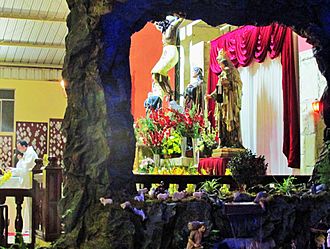Misa de Gallo facts for kids
Quick facts for kids Misa de Gallo |
|
|---|---|

Altar decorated for a Misa de Gallo
|
|
| Also called | Rooster's Mass Shepherd's Mass |
| Observed by | Roman Catholics |
| Significance | Advent season |
| Begins | December 16 |
| Ends | December 24 |
| Related to | Misa de Aguinaldo Christmas Day |
Misa de Gallo is a special Midnight Mass celebrated in Spain and many former Spanish countries. Its name means "Rooster's Mass" in Spanish. It is also called "Shepherds' Mass." This special church service happens on Christmas Eve or in the days just before Christmas.
Contents
History of Misa de Gallo
The tradition of a midnight Mass on Christmas Eve began a long time ago. A woman named Egeria from Spain wrote about it around the year 381. She visited the Holy Land and saw how early Christians in Jerusalem celebrated Christmas. They had a special service at midnight in Bethlehem. After that, they walked with torches to Jerusalem, arriving at the Church of the Resurrection at dawn.
About 50 years later, Pope Sixtus III was inspired by this midnight service. He started the tradition of a midnight Mass in Rome. This Mass was held after the "cockcrow," which was a way to mark the start of the new day.
In 1587, a priest named Diego de Soria in Mexico asked Pope Sixtus V for permission to hold the Mass outdoors. His church was too small for all the people who wanted to attend the evening celebration.
Misa de Gallo Around the World
The tradition of Misa de Gallo is still important today. It is mostly celebrated by Roman Catholic countries that speak Spanish. These include countries in Latin America and the Philippines.
Misa de Gallo in Spain
In Spain, families start Christmas Eve by lighting small oil lamps in their homes. Then, they go to church for Midnight Mass.
One of the most famous services is at the Basílica de Montserrat. This church is a Benedictine monastery built on steep cliffs. The Escolania de Montserrat, a very old boys' choir, sings during the celebration. They are known for their beautiful voices.
Misa de Gallo in Bolivia
People in Bolivia attend Christmas Eve Mass. After the service, families gather for a special meal. They often eat picana del pollo. This is a tasty stew made with chicken, peas, carrots, and potatoes.
Misa de Gallo in the Philippines
In the Philippines, Misa de Gallo is often called Simbang Gabi. This means "Night Mass" in Tagalog. It is also known as Misa de Aguinaldo, or "gift mass." This tradition usually starts on December 16 and ends on December 24.
In many parts of the Philippines, "Misa de Gallo" specifically means the very last Mass on Christmas Eve. The series of Masses is also called Misa de los Pastores in some areas. Simbang Gabi is connected to a nine-day novena procession. It also includes a play called the Panunulúyan. This play shows Joseph and the pregnant Virgin Mary searching for a place to stay.
Misa de Gallo in Puerto Rico
In Puerto Rico, people celebrate Mass by singing special Christmas songs. These songs are called aguinaldos. The more religious versions of these songs are known as villancicos. Songs with a local Criollo style are called décimas navideñas.
Misa de Gallo in Venezuela
In Venezuela, Misa de Gallo is part of a series of Masses called Misa de Aguinaldo. These Masses are held at dawn for nine days. They finish on Christmas Eve. The usual church songs are replaced by "gaita" music. This is a folk music style from the Zulia state. Gaita music is very popular throughout Venezuela during Christmas. The words of these gaita songs are religious and approved for church services.
See also
 In Spanish: Misa de Gallo para niños
In Spanish: Misa de Gallo para niños
- Rorate Coeli

